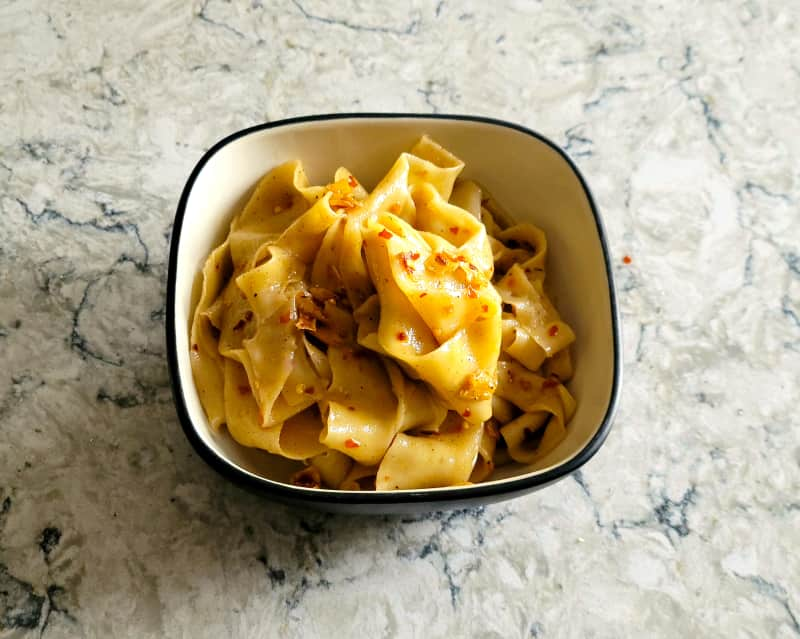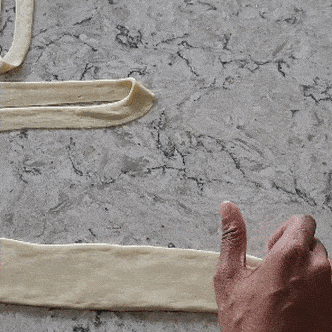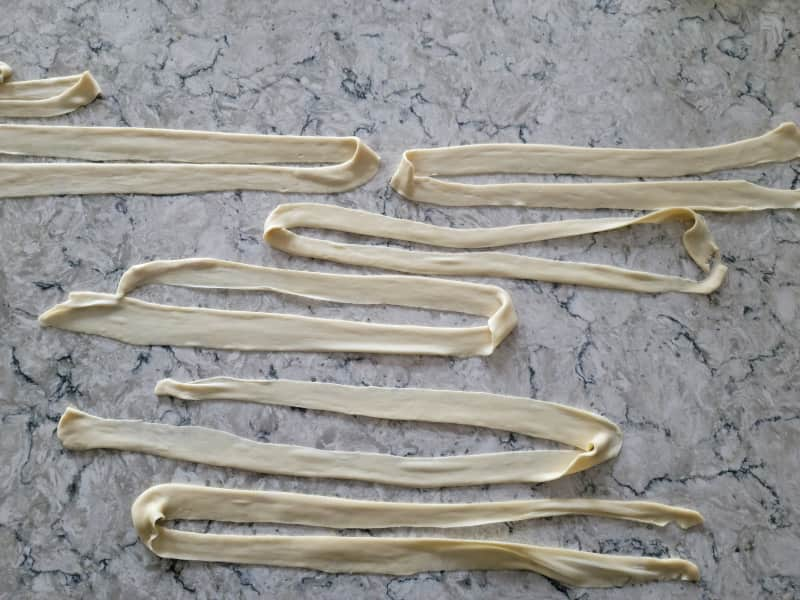I love noodles. Hot or cold, slurped or shoveled into my mouth by way of chopsticks—just keep them coming.
6 Things I Learned Hand-Pulling Noodles for the First Time
Published Apr. 5, 2022.

I frequent noodle houses; the best part is watching the dough dance in the hands of the masters while I wait for my order. The lightning-speed slap, slap, slap of the dough being pulled into noodles and then plunged into scalding water is art. But I'd always been too intimidated to make these noodles myself. Until now.
Sign up for the Notes from the Test Kitchen newsletter
Our favorite tips and recipes, enjoyed by 2 million+ subscribers!
Another thing about me: I love a project recipe. There’s nothing I enjoy more than spending time tending to dough for a homemade loaf or checking in on a sauce or soup that’s been bubbling away on the stove all day. Sure, I could just buy hand-pulled noodles, but where’s the fun in that?
For my first noodle-pulling experience, I decided on our recipe for Flat Hand-Pulled Noodles (Biang Biang Mian) with Chili Oil Vinaigrette. (Did I mention I like spicy food, too?) After watching all the videos, consulting experts, and taking notes galore . . . well, you can probably see where this is going.
Biang biang noodles hail from the Shaanxi province of China and get their name from the sound the dough makes as you slap it against the counter to stretch it and form the noodles. That’s the fun part. However, it takes time to get the dough to the pulling point, at least 12 hours (and up to 48 hours) in the fridge.
But as I learned, that first bite—with its unbelievable chew, the explosion of heat from the bird chiles, and the complexity of the toasted ginger and garlic—makes the time and effort worth it. Trust me. Or take it from Jason Wang of Xi’an Famous Foods and author of the Xi’an Famous Foods Cookbook (2020), who has mastered the technique and was kind enough to provide additional pointers to coax me through a few pitfalls.
My biggest takeaway from this experience is the importance of patience when it comes to making your own hand-pulled noodles. That and attention to detail will yield consistent, delicious results.

With four simple ingredients (bread flour, salt, water, and vegetable oil) and some elbow grease, you too can have the noodles of your dreams. Here’s what I learned.
1. For the chewiest noodles, use bread flour.
Our biang biang noodle recipe makes it clear, but don't be tempted to use all-purpose flour. The high protein content in bread flour is key here. It helps develop a strong gluten structure to give the noodles the right chewy texture. A 12 to 14 percent protein content makes bigger, stronger gluten molecules than you can get from a softer flour like all-purpose. And all that stretch translates into chewier noodles.
2. There are many methods of mixing noodle dough.
The recipe calls for making the dough in a stand mixer or a food processor. The only mixing tools I had were my hands. And it worked!
If you're in the same boat, be prepared to knead by hand for upwards of 20 minutes, until you get a smooth, satiny dough that feels good in your hands. (Watch the video above to see what the dough should look like.) If it becomes too tough to work with, cover it and let it rest for a few minutes before continuing to knead. Again: Trust me, it's worth it.
3. Don't underestimate the importance of rest.
Let the dough rest. I repeat: Let. It. Rest. The gluten has a chance to relax (and you can, too). The overnight rest is vital to maximizing the stretchiness of the noodles. When you remove the dough from the fridge, separate the dough into smaller pieces, cover them, and rest them again. This brings the dough to room temperature and further relaxes that gluten, making stretching a breeze.
Flat Hand-Pulled Noodles (Biang Biang Mian) with Chili Oil Vinaigrette
Treat yourself to these tasty noodles.4. Pull, slap, and tear with confidence (and loosen up).
This is where you will know if you followed the steps properly, and let’s just say my first batch was a disaster. The dough tore in places before it was half the length needed for separating, and thick blobs of dough formed at the ends of the noodles as I pulled them. I was encouraged by colleagues who'd made this recipe who told me to go slow as I got the hang of it (and assured me that no matter what the noodles looked like, they would still taste great).
Before I started my second batch, I checked in with Jason Wang about my technique, and he told me I was grasping onto the ends a little too hard. I needed to loosen up.
“The ends of the dough should be held like a hot potato . . . you don't want to hold on too tightly where your fingers will make indents,” he said. “This way when you pull, the dough actually leaves your hands and thins out.”


After a few more attempts, as I loosened my grip and I got into a more fluid motion, my noodle pulling began to improve. I was pretty impressed, if I do say so myself. And as you tear the noodles, don’t worry if the edges look imperfect. That’s part of the noodles’ charm! Sauces and vinaigrettes cling to those raggedy edges, so you can enjoy a distinctly luscious eating experience. (More on that in a minute.)

5. Keep your surface oiled and your dough covered.
To prevent sticking and to keep the dough supple, be sure to use vegetable oil on your countertop and on the top of the dough. Remember to cover the pieces you’re not using with plastic wrap. I forgot this step when pulling my second batch of noodles and noticed cracks forming on the edges as I pulled and separated them. They didn’t stretch as well or get as thin as I would have liked.
6. Hand-pulled noodles are a blank slate.


After cooking the noodles for just a couple minutes in boiling water, I had tender, chewy, and perfectly cooked noodles ready for slurping. For the sauce, I followed our recipe and tossed them in a chili oil vinaigrette, but the sauce possibilities really are endless here. Cooks have commented on the recipe page that they added chili crisp or tossed them in this Ginger-Scallion Everything Sauce. As for Wang's favorite way to eat them?
“At this moment I enjoy having them with our spicy cumin lamb, which is not traditionally enjoyed with noodles,” he said. “But of course hot oil–seared is the most original version.” You can never go wrong with the classics.
Give it a try. I believe in you.
